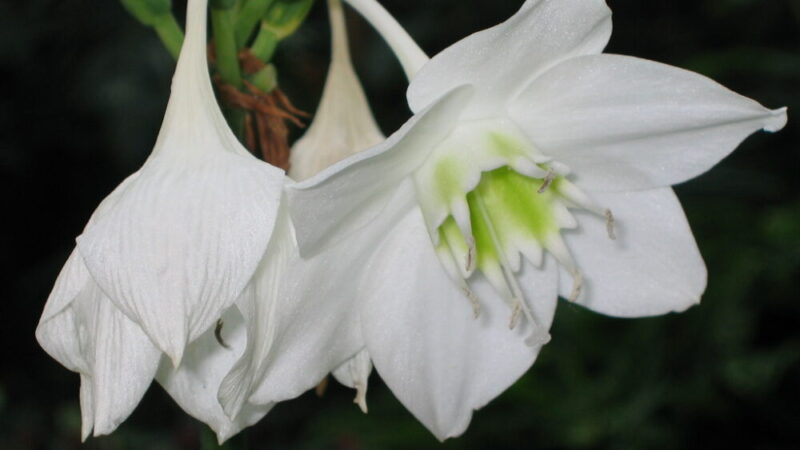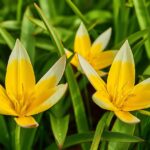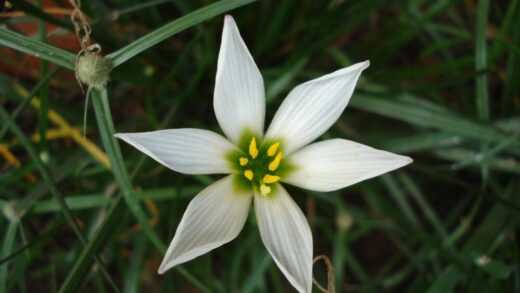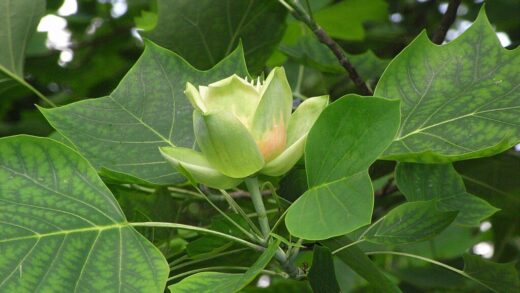Diseases and pests of the Amazon lily

While the Amazon lily is a relatively robust and resilient houseplant, it is not entirely immune to the common afflictions of pests and diseases that can affect indoor flora. Proactive care and vigilant observation are the best lines of defense, as early detection and intervention can prevent minor issues from escalating into serious threats to the plant’s health. Most problems that arise are directly linked to the growing environment, with improper watering practices being the number one culprit for diseases, and low humidity creating an inviting atmosphere for certain pests. By understanding the specific threats this plant may face, you can create a care routine that not only promotes vigorous growth but also actively deters potential problems, ensuring your plant remains a picture of health.
The most significant disease threat to the Amazon lily is bulb and root rot, a fungal condition caused almost exclusively by overwatering and poor drainage. When the soil remains waterlogged, it deprives the roots of oxygen and creates the perfect anaerobic environment for fungi like Phytophthora or Pythium to thrive. These pathogens attack the roots and the base of the bulb, causing them to turn soft, brown, and mushy. Above ground, the symptoms manifest as yellowing leaves, wilting despite moist soil, and a general failure to thrive. Prevention, through careful watering and the use of a well-draining soil mix, is infinitely more effective than trying to cure an advanced case of rot.
On the pest front, the Amazon lily can be susceptible to several common sap-sucking insects that plague houseplants, especially when the plant’s defenses are weakened by stress. The most frequent invaders are spider mites, mealybugs, and scale insects. These pests feed on the plant’s sap, robbing it of vital nutrients and moisture, which can lead to stippled or yellowing leaves, stunted growth, and a sticky residue known as honeydew. They tend to thrive in warm, dry conditions, making them a particular nuisance in centrally heated homes during the winter.
Regular inspection is the key to catching pest infestations early. At least once a week, take the time to closely examine your plant, paying special attention to the undersides of the leaves, the crevices where leaves meet the stems, and the base of the plant. Look for the pests themselves, fine webbing in the case of spider mites, or the cottony masses of mealybugs. Early intervention, often with simple mechanical or organic methods, can eradicate a small population before it has a chance to multiply and cause significant damage, keeping your plant healthy without the need for harsh chemical treatments.
Preventing bulb and root rot
The single most devastating disease that can affect an Amazon lily is rot that attacks the bulb and root system, and it is almost always a result of excessive moisture. Prevention is therefore entirely centered on providing the right soil environment and practicing meticulous water management. The first line of defense is the potting medium itself. You must use a soil mix that is light, airy, and offers superb drainage. Amending a standard potting mix with a generous portion of perlite or fine orchid bark is not an optional step; it is a necessity to ensure that water can pass through freely and that air can circulate around the roots.
More articles on this topic
The second critical component of prevention is the choice of container. Always use a pot that has at least one, and preferably multiple, drainage holes at the bottom. Without an escape route, any excess water will pool at the base of the pot, creating a stagnant, oxygen-deprived zone that is the perfect breeding ground for the fungi responsible for rot. After watering, it is imperative to ensure the pot is not left standing in a saucer of water. Always empty the saucer a few minutes after watering to remove any collected drainage, preventing the soil from reabsorbing the excess moisture.
Your watering technique itself is the third pillar of rot prevention. Never water your Amazon lily on a fixed schedule. Instead, always assess the soil’s moisture level before even thinking about reaching for the watering can. The top 2-3 centimetres of soil should feel distinctly dry to the touch before you water again. When you do water, do so thoroughly until it runs out the bottom, but then allow the plant to dry out sufficiently before the next application. This “soak and dry” method provides the roots with the moisture they need while allowing them to breathe in between waterings.
If you suspect rot due to symptoms like yellowing leaves and a wilting plant despite moist soil, you must act quickly. Carefully remove the plant from its pot and inspect the roots and bulb. Healthy roots are firm and white or pale tan, while rotted roots are brown, mushy, and may have a foul odour. Using a sterile blade, trim away all affected parts of the roots and bulb. If there is a substantial portion of the bulb that remains healthy and firm, you can try to save it by dusting the cut surfaces with a fungicide powder and repotting it in fresh, sterile, well-draining soil. Water very sparingly until new growth appears.
Identifying and treating common pests
Spider mites are one of the most common pests to affect Amazon lilies, particularly in homes with low humidity. These tiny arachnids are difficult to see with the naked eye, but their presence is betrayed by the fine, silk-like webbing they spin on the undersides of leaves and in the joints of the plant. They use their piercing mouthparts to suck the contents out of plant cells, leading to a fine, stippled pattern of yellow or white dots on the leaves. As the infestation progresses, leaves may turn yellow or bronze and eventually drop off. To combat spider mites, start by increasing the humidity around the plant and regularly wiping the leaves with a damp cloth or spraying the plant down in the shower to dislodge them. For more persistent infestations, an insecticidal soap or neem oil spray can be very effective.
More articles on this topic
Mealybugs are another frequent nuisance, appearing as small, white, cottony masses in the protected areas of the plant, such as the leaf axils and along the veins on the undersides of the leaves. These soft-bodied insects also feed on plant sap, and a heavy infestation can lead to stunted growth and leaf drop. They also excrete a sticky substance called honeydew, which can attract sooty mould. For small outbreaks, you can remove individual mealybugs using a cotton swab dipped in rubbing alcohol. For larger problems, a thorough spray with neem oil or insecticidal soap, ensuring you get into all the nooks and crannies where they hide, is the best course of action.
Scale insects are more subtle pests that can be easily mistaken for a natural part of the plant. They appear as small, hard or soft, immobile bumps, typically brown or tan in colour, attached to the stems and the undersides of the leaves. Like mealybugs, they feed on sap and excrete honeydew. The hard, waxy shell of adult scale insects protects them from many contact insecticides. Therefore, treatment often involves carefully scraping them off with a fingernail or a soft brush, or dabbing each one with a cotton swab soaked in rubbing alcohol to dissolve their protective coating. Systemic insecticides can be effective for severe infestations, but manual removal is often sufficient if caught early.
The key to successful pest management is persistence and thoroughness. Most pest treatments, especially organic ones like neem oil, need to be reapplied every 7-10 days for several weeks to break the life cycle of the pests, as the initial application may not kill the eggs. Always spray the entire plant, paying close attention to the undersides of the leaves where pests love to congregate. Isolating an infested plant from your other houseplants is also a crucial step to prevent the problem from spreading throughout your collection.
Fungal and bacterial leaf spots
While less common than root rot, Amazon lilies can occasionally develop fungal or bacterial leaf spot diseases. These typically manifest as distinct spots or blotches on the leaves. The appearance of these spots can vary; they may be brown, black, or tan, and sometimes they have a yellow halo around the edge. Fungal leaf spots often have a more circular shape and may develop tiny black dots in the centre, which are the fruiting bodies of the fungus. These diseases are most prevalent in conditions of high humidity combined with poor air circulation, where water is allowed to sit on the leaves for extended periods.
The first step in managing a leaf spot issue is to immediately improve the plant’s environmental conditions. Prune off the most heavily affected leaves using a sterile pair of scissors or shears to reduce the amount of pathogen present on the plant. Be sure to disinfect your tool with rubbing alcohol between each cut to avoid spreading the disease to healthy tissue. After pruning, focus on increasing air circulation around the plant. This can be as simple as spacing your plants further apart or, in very still environments, using a small fan to create gentle air movement.
Proper watering technique is also crucial in preventing and controlling leaf spot diseases. When you water your Amazon lily, try to apply the water directly to the soil surface, avoiding splashing water onto the leaves as much as possible. If the leaves do get wet, it is important that they can dry quickly. This is why watering in the morning is always recommended over watering in the evening, as it gives the foliage the entire day to dry out. Wet leaves overnight create an ideal environment for fungal and bacterial spores to germinate and infect the plant.
If the leaf spot problem persists or is severe despite these cultural adjustments, a fungicide or bactericide may be necessary. For fungal spots, a copper-based fungicide or a broad-spectrum bio-fungicide can be effective. It is important to follow the product’s application instructions carefully. However, for most minor leaf spot issues on an indoor Amazon lily, improving the environmental conditions and removing the affected leaves is usually sufficient to resolve the problem without resorting to chemical treatments.
Environmental stress factors
Beyond specific pests and diseases, the Amazon lily can also show signs of distress due to suboptimal environmental conditions. These stress factors can weaken the plant, making it more susceptible to actual diseases and pest infestations. One of the most common environmental problems is leaf scorch, which is caused by exposure to direct, intense sunlight. This appears as large, dry, brown or bleached-looking patches on the parts of the leaves that receive the most sun. The solution is simple: move the plant to a location where it only receives bright, indirect light. The damaged parts of the leaves will not recover, but the plant will produce new, healthy foliage in the correct lighting.
Another common sign of environmental stress is yellowing leaves, a symptom that can unfortunately point to several different issues. Overwatering is the most frequent cause, leading to a generalized yellowing of the lower leaves first. However, underwatering can also cause leaves to yellow and wilt as the plant becomes dehydrated. A nutrient deficiency, particularly a lack of nitrogen, can also result in pale green or yellow leaves. To diagnose the cause, you must assess all aspects of your care routine: check the soil moisture, review your watering habits, and consider when you last fertilized the plant.
Low humidity is a significant stressor for this tropical native. In dry indoor air, especially during winter when heating systems are running, the edges of the leaves may turn brown and crispy. While this is primarily a cosmetic issue, severe and prolonged low humidity can weaken the plant overall. To combat this, you can employ several methods to increase the ambient moisture. Grouping the Amazon lily with other plants, placing it on a pebble tray filled with water, or using a room humidifier are all highly effective strategies for creating a more comfortable, humid microclimate.
Sudden changes in the environment can also shock the plant, leading to symptoms like leaf drop or a sudden cessation of growth. This can happen if the plant is moved from a low-light location to a very bright one, or if it is exposed to a sudden cold draft. When you need to change the plant’s location or conditions, it is always best to do so gradually if possible. By providing a stable and appropriate environment, you can prevent these stress-related symptoms and maintain a consistently healthy and resilient plant.
Creating a healthy growing environment
Ultimately, the most effective strategy for dealing with diseases and pests is to prevent them from ever taking hold in the first place. This is achieved by creating a robustly healthy growing environment that supports the plant’s natural defense mechanisms. A healthy, thriving plant is far less attractive to pests and more resistant to diseases than one that is stressed or weakened. This holistic approach begins with providing the foundational elements of care correctly: the right light, the right soil, and the right temperature.
Good sanitation, or “plant hygiene,” is a simple but powerful preventative measure. Regularly remove any yellowing or dead leaves from the plant and clear away any fallen debris from the soil surface. This organic matter can be a breeding ground for fungi and pests. When you bring a new plant into your home, it is always a wise practice to quarantine it for a few weeks in a separate room from your existing collection. This isolation period gives you time to observe the new plant for any signs of pests or diseases before potentially introducing them to your other plants.
Adequate air circulation is another key component of a healthy environment, particularly for preventing fungal diseases. In stagnant air, moisture can linger on leaves and in the soil, creating perfect conditions for pathogens. Ensure there is some space between your plants to allow air to move freely around them. This doesn’t mean placing your Amazon lily in a draft, which it dislikes, but simply avoiding overly crowded conditions. In some cases, a small, oscillating fan set on low in the room can make a significant difference.
Finally, a proactive and observant approach is your greatest asset. Make a habit of spending a few moments with your plant every few days, not just to water it, but to truly look at it. Notice the colour and texture of its leaves, check for any unusual spots or residues, and look for any tiny unwelcome guests. This regular, attentive observation allows you to catch the very first signs of trouble. By combining a stable, optimal environment with this kind of vigilance, you can ensure your Amazon lily remains a disease- and pest-free specimen for many years.
📷: Flickr / Szerző: 阿橋花譜 HQ Flower Guide / Licence: CC BY-SA 2.0



















